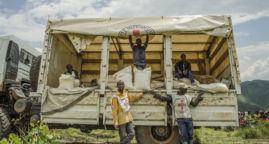The Geopolitics of Environmental Challenges
Article published on project syndicate website on 03/02/2017 by Giulio Boccaletti
Much of the world seems to be on edge. The West’s relationship with Russia, the future of NATO, the Syrian civil war and refugees, rising right-wing populism, the impact of automation, and the United Kingdom’s impending departure from the European Union: all of these topics – and more – have roiled public debate worldwide. But one issue – one might say the most significant of them all – is being ignored or pushed aside: the environment.
That was the case at this year’s annual meeting of the World Economic Forum at Davos, Switzerland. Beyond a mention of the Paris climate agreement by Chinese President Xi Jinping, topics like climate change and sustainable development didn’t even make it to the main stage. Instead, they were relegated to side meetings that rarely seemed to intersect with current political and economic events.
Allowing environmental issues to fall by the wayside at this time of geopolitical and social instability is a mistake, and not just because this happens to be a critical moment in the fight to manage climate change. Environmental degradation and natural-resource insecurity are undermining our ability to tackle some of the biggest global issues we face.
Environmental insecurity is a major, though often underestimated, contributor to global instability. The UN High Commission on Refugees reports that natural disasters have displaced more than 26 million people per year since 2008 – almost a third of the total number of forcibly displaced people in this time period.
Even the current refugee crisis has an environmental element. In the years leading up to the war, Syria experienced its most extreme drought in recorded history. That drought, together with unsustainable agricultural practices and poor resource management, contributed to the internal displacement of 1.5 million Syrians and catalyzed political unrest ahead of the 2011 uprising.
The link between environmental and agricultural pressures extends far beyond Syria. Over-reliance on specific geographies for agriculture means that food production can exacerbate environmental problems, or even create new ones. This can pit global consumer interests against local citizen interests, as it has along the Mississippi River, where fertilizer runoff from one of the world’s breadbaskets is contributing to concerns about water quality.
The connection goes both ways, with environmental conditions also shaping agricultural production – and, in turn, the prices of agricultural commodities, which represent about 10% of traded goods worldwide. For example, rising temperatures and altered precipitation patterns are already driving up the price of coffee. With the global land area suitable for growing coffee set to contract by up to half by 2050, price pressures will only intensify.
A sudden shift toward trade protectionism could drive up agricultural commodity prices further. Such an increase would affect farm-level household income, favoring some farmers while harming others. End consumers, particularly the poor and vulnerable, would also suffer.
Another reason why the environment should be at the center of economic debates is its role as the world’s single largest employer. Almost a billion people, just under 20% of the world’s labor force, are formally employed in agriculture. Another billion or so are engaged in subsistence farming, and therefore don’t register in formal wage statistics.
Any initiatives to support economic development must support this population’s transition toward higher-productivity activities. This is particularly important at a time when increasingly sophisticated and integrated technology threatens to leapfrog an entire generation of workers in some countries. Efforts to benefit this huge population must focus not only on training and education, but also on new models that allow countries to capitalize on their natural capital – the landscapes, watersheds, and seascapes – without depleting it.
Just as natural-resource insecurity can cause displacement and vulnerability, effective natural-resource management can support conflict resolution and sustainable economic development. On this front, efforts to achieve environmental remediation, to boost the resilience of rural communities, to advance sustainable agricultural production, and to support community-based environmental stewardship have all shown promising results.
Consider the Northern Rangelands Trust, an organization focused on creating community conservancies to enable sustainable and equitable land use in Kenya. NRT has helped pastoralist communities establish effective governance mechanisms for the environment on which they depend, reducing conflict over grazing rights, especially in times of drought.
For many communities, members’ relationship with the landscape in which they live is an integral part of their identity. With effective governance and planning, open dialogue, resource-sharing frameworks, and sufficient investment, including in skills training, these communities can translate this relationship into effective environmental stewardship – and build healthier and more secure societies.
The crises engulfing the modern world are complex. But one thing is clear: the environment is connected to all of them. Solutions will mean little without a healthy world in which to implement them.
Related Articles
We CAN end hunger but only if we end conflict
November 2017. The vicious cycle of conflict and hunger must be broken if we are to achieve a world where everyone has enough to eat.
After Davos, let’s turn talk into action
01/29/2019. Combining humanitarian expertise, local know-how, and private sector acumen could help aid 800 million people around the world
Five rare humanitarian success stories of 2016 (plus caveats)
12/29/2016. It’s hard to see the silver lining around a year as awful as 2016, but a few good news stories did emerge.






